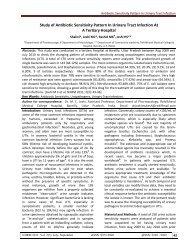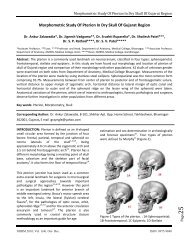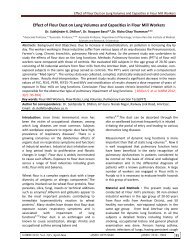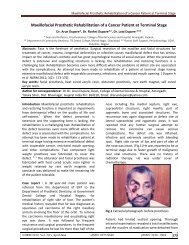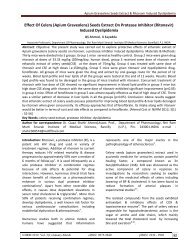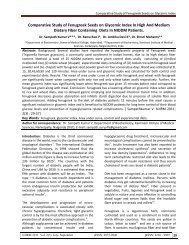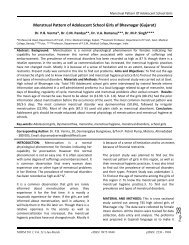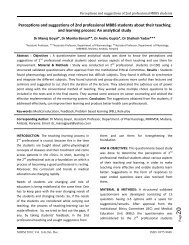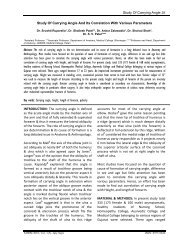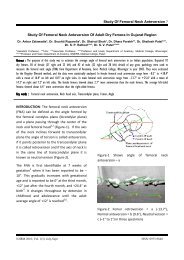Role Of Placenta To Combat Fluorosis - Njirm.pbworks.com
Role Of Placenta To Combat Fluorosis - Njirm.pbworks.com
Role Of Placenta To Combat Fluorosis - Njirm.pbworks.com
You also want an ePaper? Increase the reach of your titles
YUMPU automatically turns print PDFs into web optimized ePapers that Google loves.
Page16<br />
<strong>Role</strong> <strong>Of</strong> <strong>Placenta</strong> <strong>To</strong> <strong>Combat</strong> <strong>Fluorosis</strong><br />
<strong>Role</strong> <strong>Of</strong> <strong>Placenta</strong> <strong>To</strong> <strong>Combat</strong> <strong>Fluorosis</strong> (In Fetus) In Endemic <strong>Fluorosis</strong> Area<br />
Gurumurthy Sastry. M*, Shruti Mohanty**, Pragna Rao**<br />
*Dept. of Biochemistry, Mediciti institute of medical sciences, Ghanpur, Medchal Mandal, RR Dist.-501401, AP, India. **Dept. of<br />
Biochemistry, Kamineni Institute of Medical Sciences, Sreepuram, Narketpally (M), Nalgonda, AP, India.<br />
Abstract : Fluoride (F) is known to cross the placenta from the maternal blood to the growing fetus. However,<br />
there are few studies on the role of placenta in conditions of high F intake in fluorosis endemic area. The present<br />
study is the first of its kind carried out in Nalgonda district, an endemic fluorosis area of Andhra Pradesh, India<br />
with an average ground and drinking water F of 10.94+2.09 ppm and 4.4+1.6 ppm respectively. The aim of the<br />
study is to determine the role of placenta in the transport of F from the maternal blood to the fetus in fluorosis<br />
endemic area. 200 healthy pregnant women aged 17-36 years were inducted in the study. All the women had<br />
normal and uneventful delivery. Samples collected were maternal blood, cord blood & placenta. The placenta<br />
was divided into three parts- peripheral, maternal and fetal surfaces. <strong>Placenta</strong>l extracts were obtained and<br />
stored at -20° C until processed. F concentrations of the newborn were well within the normal reference range<br />
despite high maternal F concentrations (1.62±0.78 ppm). <strong>Placenta</strong>l F concentration on the peripheral side<br />
(2.54±1.55 ppm) was two fold higher than the maternal serum F (1.62±0.78 ppm; p< 0.001) and six fold higher<br />
than the cord F (0.45±0.35 ppm; p< 0.001). <strong>Placenta</strong>l F on the maternal (1.62±0.78 ppm) and fetal surfaces<br />
(1.41±0.77 ppm) were three fold higher than that of cord blood (p
Page17<br />
<strong>Role</strong> <strong>Of</strong> <strong>Placenta</strong> <strong>To</strong> <strong>Combat</strong> <strong>Fluorosis</strong><br />
according to the guidelines given by clinical and<br />
laboratory standards institute/ NCCLS (National<br />
Clinical Chemistry Laboratory Standards) 6, 7 . The<br />
blood samples were centrifuged at 3000 rpm for 10<br />
minutes and the serum was immediately analyzed<br />
for F.<br />
The placenta was divided into a central part and<br />
marginal part. The central part was further<br />
subdivided into maternal and fetal surfaces. 10 gm<br />
of tissue was cut from each part. These tissues were<br />
homogenized immediately using 10 mL normal<br />
saline at 100,000 rpm for 45 min in a pressure<br />
driven tissue homogenizer. Precautions were taken<br />
according to those given in the manual of the tissue<br />
homogenizer. Briefly, the speed of the homogenizer<br />
was not increased or decreased abruptly. It is done<br />
gradually; homogenization was always done in ice<br />
pack as it generates heat. The homogenization<br />
procedure developed was standardized and<br />
validated against other procedures 8,9 .The tissue<br />
extract was processed immediately for F analysis.<br />
The homogenate was transferred into a centrifuge<br />
tube and centrifuged at 3000rpm for 5min. Now the<br />
total volume (Volume of buffer + volume of tissue<br />
fluid) was noted and the approximate dilution of<br />
the tissue fluid is calculated. F was analyzed by ion<br />
selective procedure at pH 5.0 adjusted with TISAB<br />
(<strong>To</strong>tal Ionic Strength Adjustment Buffer) III buffer<br />
using Eutech Epoxy Body Electrode. The instrument<br />
was calibrated and standardized using four<br />
solutions having F concentrations of 0.01 ppm, 0.1<br />
ppm, 1 ppm and 10 ppm. The standards were run<br />
before analysis of each sample and the electrode<br />
was calibrated periodically. Other measures were<br />
followed according to those given in the instrument<br />
manual. Briefly, all solutions were analyzed in<br />
plastic ware and not glass ware; the electrode was<br />
calibrated everyday, and samples were processed<br />
after checking the controls for each batch of ten<br />
samples.<br />
Drinking and ground water was brought by the<br />
family members of the subjects on request for F<br />
analysis since water was the major source of<br />
fluoride intake.<br />
The data was processed in MS EXCEL and analysis<br />
was carried out using SPSS (17 th version). The<br />
results were statistically analyzed by the Student’s<br />
t-test and by Pearson’s correlation coefficient. A<br />
two tailed probability value of < 0.05 was taken as<br />
indicating significance.<br />
RESULTS : All the subjects in the study were<br />
resident of Nalgonda district (an endemic fluorosis<br />
area) since childhood. These subjects use<br />
Government supplied Krishna River water for<br />
drinking and ground water for house hold activities<br />
like washing, cleaning etc, and also for cooking.<br />
Ground and drinking water samples were provided<br />
by all the participants (n=200) and the F levels in<br />
the water samples were 10.64 ± 2.09 ppm and 4.4<br />
± 1.6 ppm respectively. These subjects depend on<br />
locally grown food crops and vegetables for their<br />
daily requirements. The water sources suggest<br />
higher intake of F than the maximum, 1.5 ppm,<br />
re<strong>com</strong>mended by WHO and Indian Standard Code<br />
for Drinking Water 1, 2 . The demographic detail of<br />
the subjects is presented in table 1.<br />
Table1: Demographics of subjects (n=200).<br />
Parameters Range Mean + SD<br />
Age group (Years) 17-36 26.4+5.2<br />
Weight (Kgs.) 40-60 48.0+ 5.2<br />
Gravida 1 to 4<br />
Parity 0 to 4<br />
Type of delivery<br />
1. Vaginal n = 84<br />
2. Lower Segment<br />
Caesarean Section<br />
n = 116<br />
F values in the samples are presented in Table2.<br />
N NJIRM 2010; Vol. 1(4).Oct- Dec. ISSN: 0975-9840
Page18<br />
<strong>Role</strong> <strong>Of</strong> <strong>Placenta</strong> <strong>To</strong> <strong>Combat</strong> <strong>Fluorosis</strong><br />
Table 2: Fluoride levels in placental extracts, maternal and cord serum.<br />
FLUORIDE CONCENTRATIONS (PPM)<br />
Maternal<br />
Serum<br />
Cord Serum<br />
Maternal Surface<br />
of <strong>Placenta</strong><br />
Fetal Surface<br />
of <strong>Placenta</strong><br />
Marginal Part<br />
of <strong>Placenta</strong><br />
Mean 1.62 0.45 1.62 1.41 2.54<br />
SD 0.78 0.35 0.78 0.77 1.55<br />
Median 1.71 0.32 1.42 1.23 2.36<br />
Max 3.60 1.80 5.60 3.60 7.80<br />
Min 0.30 0.10 0.66 0.13 0.72<br />
These values indicate that F is essentially<br />
concentrated on marginal part of placenta. A strong<br />
positive correlation, r= 0.914349(p
Page19<br />
<strong>Role</strong> <strong>Of</strong> <strong>Placenta</strong> <strong>To</strong> <strong>Combat</strong> <strong>Fluorosis</strong><br />
to F. Further, there is a need to translate similar<br />
type of <strong>com</strong>munity research into <strong>com</strong>munity health<br />
practice for the benefit of the population at large.<br />
The present study supports the view that the<br />
placenta has a protective role on fetus by<br />
preventing transfer of excess F to the growing fetus<br />
and the capacity of placenta as F filter is still a point<br />
of debate. When the drinking water and food has<br />
high F concentration, the F content of the placenta<br />
is significantly higher than that of the mother<br />
serum, while the cord blood has the least. Thus,<br />
these findings indicate that the placenta represents<br />
a natural barrier to the passage of larger quantities<br />
of F to the fetus probably by binding to calcium ions<br />
in the placenta. Further studies are essential to<br />
demonstrate and establish these observations.<br />
ACKNOWLEDGEMENTS : Authors are thankful to<br />
Kamineni Education Society for constant<br />
encouragement and funding for research. Dr<br />
Clareann H Bunker, Associate Professor,<br />
Department of Epidemiology, University of<br />
Pittsburgh, Pittsburgh, PA 15261 for her valuable<br />
suggestions in writing this manuscript. Patients of<br />
the study and their family members for their<br />
support and consent. Ms. Subhashini, Nursing<br />
Incharge, Dept. of Obstetrics and Gynecology, KIMS,<br />
for her help to collect samples.<br />
REFERENCES:<br />
1. WHO Guidelines for Drinking Water Equality,<br />
World Health Organisation, Geneva, 1984, 2:249<br />
2. BIS: 10500, “Indian Standard code for drinking<br />
water”, BIS, INDIA, 1983.<br />
3. Caldera R, Chavinie J, Fermanian J, <strong>To</strong>rtrat D,<br />
Laurent A M. Maternal- Fetal transfer of fluoride in<br />
pregnant women. Bio Neonate 1988; 54(5):263-9.<br />
4. Forestier F, Daffos F, Said R, Brunet CM,<br />
Guillaume PN. The passage of fluoride across<br />
placenta. An intra-uterine study. J. Gynecol Obstet<br />
Biol Reprod 1990; 19(2): 171-5.<br />
5. Shimonovitz S, Patz D, Ever- Hadani P, Singer L,<br />
Zacut D, Kidroni G, et al. Umbilical cord fluoride<br />
serum levels may not reflect fetal fluoride status. J<br />
Perinat Med 1995; 23(4): 279-82.<br />
6. Procedures for the collection of diagnostic<br />
blood specimens by venipuncture: Approved<br />
standard. 4 th ed. Wayne PA: National <strong>com</strong>mittee for<br />
Clinical Laboratory Standards, 1998.<br />
7. Procedures for handling and transport of<br />
domestic diagnostic specimens and etiologic agents:<br />
Approved standard. 3 rd ed. Wayne PA: National<br />
<strong>com</strong>mittee for Clinical Laboratory Standards, 1994.<br />
8. McArdle HJ, Douglas AJ & Morgan EH 1984<br />
Transferrin binding by microvillar vesicles isolated<br />
from rat placenta. <strong>Placenta</strong> 5 131–138.<br />
9. Angela M Finch, Li G Yang, Margaret O Nwagwu,<br />
Kenneth R Page, Harry J McArdle and Cheryl J<br />
Ashworth. <strong>Placenta</strong>l transport of leucine in a<br />
porcine model of low birth weight. Reproduction<br />
2004; 128: 229-35.<br />
10. Itaik, Tsunoda H. Highly sensitive and rapid<br />
method for determination of fluoride ion<br />
concentrations in serum and urine using flow<br />
injection analysis with a fluoride ion selective<br />
electrode. Clin Chim Acta 2001; 308:163-71.<br />
11. Feltman, R., and Kossel, G.: Prenatal Ingestion<br />
of Fluorides and Their Transfer to the Fetus. Science<br />
1955; 122:560.<br />
12. Li XS, Zhi JL, Gao RO, Effect of fluoride exposure<br />
on intelligence in children. Fluoride 1995. 28:189-<br />
192.<br />
13. Gupta S, Seth AK, Gupta A, Gavane AG.<br />
Transplacental passage of fluorides. J Pediatr<br />
1993; 1233(1):139-41.<br />
14. Shen YW, Taves DR. Fluoride concentrations in<br />
the human placenta and maternal and cord blood.<br />
Am J Obstet Gynecol 1974; 119 (2): 205-7.<br />
15. Opydo-Szymack, Borysewicz-Lewicka.<br />
Transplacental passage of Fluoride in pregnant<br />
Polish women assessed on the basis of Fluoride<br />
concentrations in maternal and cord blood plasma.<br />
Fluoride 2007; 40 (1): 46-50<br />
16. Malhotra A, Tewar A, Chawla HS, Gauba K, Dhall<br />
K. <strong>Placenta</strong>l transfer of Fluoride in pregnant women<br />
consuming optimum Fluoride in drinking water. J<br />
Indian Soc Pedod Prev Dent 1993; 11 (1): 1-3.<br />
17. Committee on <strong>To</strong>xicology, National Research<br />
Council of the National Academies. Health effects of<br />
Ingested Fluoride. Washington, DC: National<br />
Academy of Sciences Press; 1993.<br />
N NJIRM 2010; Vol. 1(4).Oct- Dec. ISSN: 0975-9840



